Bryanna Clark Grogan’s Vegan Feast Kitchen/ 21st Century Table: The kitchen journal of a vegan food writer.. I'm on Facebook and Twitter (see links in sidebar at right).
Thursday, March 22, 2007
100% WHOLE WHEAT BREAD AND MY NEW GRAIN MILL

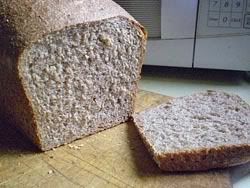
100% wholewheat bread made with freshly-milled hard red wheat
I just got a new grain mill. I've had a Magic Mill Plus III for many years, but it needs a bit of work and it is not being made anymore. We used it alot because both my DH and I make bread--DH makes it for private customers several times a week, in fact. So we have a new mill now, the Wondermill.
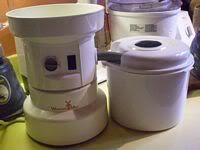
My new Wondermill (UPDATE: See this post for info about the new 2014 Wondermill.)
It is a totally different design than the Magic Mill Plus III, but the grinding mechanism is the same principle-- the "impact" or micronizer, which uses steel "teeth" or blades to mill grains or legumes into flour. (The Wondermill can grind legumes into flour, which was not recommended with the Magic Mill, so that's a plus!) The Wondermill makes a lovely fine flour. (BTW, you can't make cracked grain or very coarse flour with micronizer-type mills.) You can see the bran, which you can just mix in evenly. If you want to have a healthier type of pastry flour, but a little finer than all wholewheat, grind soft wheat kernels (soft wheat contains less gluten-- good for pie crusts, pastries, cakes and quick breads, and also for low-fat baking) and then sift out the coarse bran. Some of the finer bran and the wheat germ will stay behind with the flour. The bran can be used in cereals, muffins, etc.
The Wondermill is also quieter than the Magic Mill when it is actually milling grain (be advised, though, that no electric mill is quiet!), and it is ALOT easier to clean! I also found that there was no need to drape everything on my kitchen counter in towels (like I used to have to do!) to prevent a film of flour on everything (to be fair, my old Magic Mill needs a new gasket!).
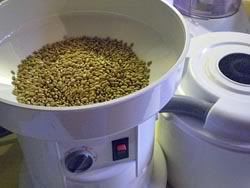
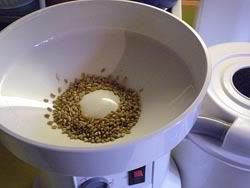
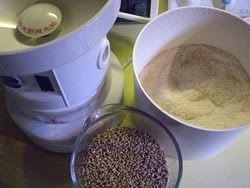
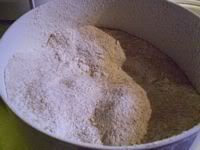
The Wondermill in action and with freshly-milled flour
Notice the container connected to the mill by a grey tube. The flour goes straight into the container and can be stored in it (some people get two containers, to have one for fresh-milling, and one for storage).
For more info about the Wondermill, dealers, reviews, go to this page .
One of the best reasons for having a grain mill (besides cost-- it's cheaper to grind organic grain than to purchase good organic flours, especially flours other than wheat-- particularly of benefit to those with food allergies and celiac disease), is freshness. As soon as grains are ground, they start to lose nutrients (just like vegetables after they are picked). So, the fresher your flour is, the better the nutrient content.
Yesterday, to try out the mill, I wanted to make a batch of bread with flour made seconds before I mixed it with the liquid ingredients, so I mixed my warm water and yeast in the Bosch mixer before I ground the grain. When the yeast was frothy, I dumped in the fresh flour warm from the grinder! Below is the recipe I prefer, and some photos of the process and the result, which was two light, moist, naturally-sweet-tasting 100% wholewheat loaves!
PS: I'LL POST A BREAD-MACHINE VERSION SOON!
TWO-LOAF BATCH OF WHOLEWHEAT BREAD (see the recipe below):
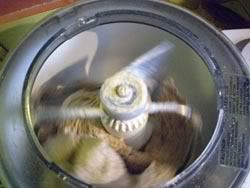
Kneading in the Bosch
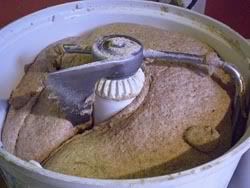
Risen dough-- who says you can't have light wholewheat bread?
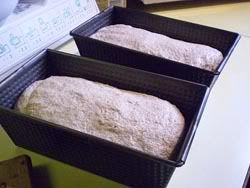
Dough in the pans before the second rising. We use the 8x4.4x3" Norpro
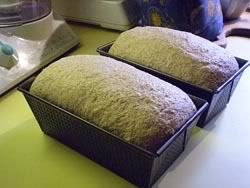

Loaves risen the second time, before and after slashing with a razor blade and ready for the oven.
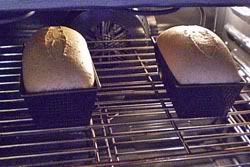
After five minutes in a very hot oven, just before turning the heat down
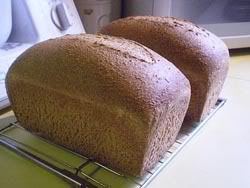 Fresh out of the oven!
Fresh out of the oven!
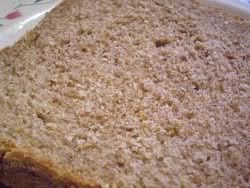
Close-ups of the cooled bread sliced, showing the nice moist crumb. It's not dry at all, and slices beautifully!
MY BREAKFAST THIS MORNING:
My husband says I eat weird things for breakfast sometimes! Maybe so, but this was delicious!
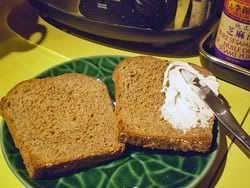

Wholewheat toast with Creamy Sheese Original and pea shoots (pea sprouts)!
UPDATE: My recipes for 100% wholewheat bread machine bread and no-knead 100% moist and tender wholewheat sandwich bread.
THE RECIPE:
Printable Recipe
BRYANNA'S BASIC TENDER 100% WHOLEWHEAT BREAD
Servings: 36/ 3/8"-thick slices
Yield: 2 loaves
You can double this recipe to make 4 loaves, but DO NOT double the yeast!
IMPORTANT NOTE! Before making this recipe, get an inexpensive oven thermometer and test the heat of your oven. Many ovens are as much as 100° off, even new ones! If it is seriously off, have it calibrated by someone from a company that sells and fixes stoves and ovens. Otherwise, you may have to adjust the temperature up or down when you bake.
I have been making this recipe for many, many years, but it has been perfected using my husband's unique baking technique, which makes a moist bread with a nice crust. This bread has at least one nice, long rise, which is the secret to making bread that has good flavor without using lots of sweeteners and fats. DO NOT cut corners on the time and try to use more yeast instead! Your bread will suffer.
2 3/4 cups very warm potato cooking water
OR warm water water plus 1/4 c. instant potato flakes (you can get the organic variety)
(you can get the organic variety)
1 Tbs sweetener of choice (I use organic sugar )
)
1 1/2 tsp. (1/2 Tbs.) dry active baking yeast (please DO NOT increase this amount!) OR 1 tsp. instant yeast
(please DO NOT increase this amount!) OR 1 tsp. instant yeast
1/4 cup ground golden flax (optional)
(optional)
1 Tbs sea salt (please DO NOT reduce this amount or leave out-- salt is important to regulate rising, as well as for taste)
(please DO NOT reduce this amount or leave out-- salt is important to regulate rising, as well as for taste)
2 Tbs oil
6-7 cups fresh wholewheat flour (4 1/2 c. hard wheat kernels [red
[red or white
or white varieties] will mill into just about this amount of flour)
varieties] will mill into just about this amount of flour)
OPTIONAL: raw sesame seeds to sprinkle on the bottom of the pan
NOTE: Why use potato water? Well, for one thing, it's a good use of water from cooking potatoes. But, seriously, the potato seems to help make 100% wholewheat bread nice and light-- I'm not sure why.
TO MAKE THE BREAD:
Dissolve the yeast in the potato water, along with the sweetener (I do this right in the bowl of my Bosch mixer). When bubbly, mix with the remaining ingredients, using a large bowl (or bowl of a heavy-duty mixer), including about 4 c. of the flour.
When that is well mixed, mix or knead in 2 more cups of the remaining flour. If the dough is too sticky, add the remaining 1 cup, a little at a time, but aim for a moist dough. I usually use the whole 7 cups, but the amount sometimes depends on the weather or the flour itself.
Knead in a heavy-duty mixer with a dough-hook (such as a Bosch) or by hand 10 minutes. (If kneading by hand, use as little flour as possible. Use a little oil on your hands and the kneading surface, if necessary. This prevents the addition of too much flour during kneading, which will make a dry dough.)
A two-loaf batch such as this one can be risen right in the Bosch bowl, with the cover on. However, you can transfer it to a large oiled bowl, oil the top, cover with plastic wrap (or place the whole bowl inside of a new small white bin-liner-bag and twist-tie it, leaving room for rising), and let rise for about 1 and 1/2 to 2 hours on the counter at normal room temperature (I prefer 2 hours to activate the enzymes which make bread taste good, and improve texture).
Shape into 2 even loaves and place in (greased, if necessary) 8-8 1/2" x 4 1/2" loaf pans. (If you like, sprinkle the bottoms of the pan first with a few raw sesame seeds. My husband always does this and it lends a little extra something to the flavor!)
Cover the loaves loosely (I place the pans inside of a new small white bin-liner-bag and twist-tie it, leaving room for rising) and let rise about 30-45 minutes, or until well-rounded over the tops of the pans.
After about 15 minutes of rising, preheat oven to 480 degrees F with convection, 500 degrees F without.
Just before baking, slash the loaves with a razor blade (see photo above), and spray the loaves with water from a pump-sprayer (this helps you get a nice "oven-spring"). Place the loaves in the middle of the oven, and bake for 5 minutes. IMMEDIATELY LOWER HEAT TO 400 degrees F with convection, 410 degrees without (if you are baking 4 loaves at once, make the temperature 410 degrees F with convection, 425 degrees without), and bake for about 20-25 minutes (I baked them 20 minutes), or until golden brown and hollow-sounding when tapped on the bottom.
If your oven heat is uneven, switch the loaves around to different positions after the first 10 minutes at the lower temperature. Remove the loaves from pans immediately and cool on racks before slicing.
Nutrition Facts
Nutrition (per slice): 93.7 calories; 14% calories from fat; 1.5g total fat; 0.0mg cholesterol; 190.3mg sodium; 108.3mg potassium; 18.0gcarbohydrates; 3.2g fiber; 0.5g sugar; 14.8g net carbs; 3.5g protein; 1.4 points.
Happy baking!

BRYANNA'S BASIC TENDER 100% WHOLEWHEAT BREAD
Servings: 36/ 3/8"-thick slices
Yield: 2 loaves
You can double this recipe to make 4 loaves, but DO NOT double the yeast!
IMPORTANT NOTE! Before making this recipe, get an inexpensive oven thermometer and test the heat of your oven. Many ovens are as much as 100° off, even new ones! If it is seriously off, have it calibrated by someone from a company that sells and fixes stoves and ovens. Otherwise, you may have to adjust the temperature up or down when you bake.
I have been making this recipe for many, many years, but it has been perfected using my husband's unique baking technique, which makes a moist bread with a nice crust. This bread has at least one nice, long rise, which is the secret to making bread that has good flavor without using lots of sweeteners and fats. DO NOT cut corners on the time and try to use more yeast instead! Your bread will suffer.
2 3/4 cups very warm potato cooking water
OR warm water water plus 1/4 c. instant potato flakes
1 Tbs sweetener of choice (I use organic sugar
1 1/2 tsp. (1/2 Tbs.) dry active baking yeast
1/4 cup ground golden flax
1 Tbs sea salt
2 Tbs oil
6-7 cups fresh wholewheat flour (4 1/2 c. hard wheat kernels
OPTIONAL: raw sesame seeds to sprinkle on the bottom of the pan
NOTE: Why use potato water? Well, for one thing, it's a good use of water from cooking potatoes. But, seriously, the potato seems to help make 100% wholewheat bread nice and light-- I'm not sure why.
TO MAKE THE BREAD:
Dissolve the yeast in the potato water, along with the sweetener (I do this right in the bowl of my Bosch mixer). When bubbly, mix with the remaining ingredients, using a large bowl (or bowl of a heavy-duty mixer), including about 4 c. of the flour.
When that is well mixed, mix or knead in 2 more cups of the remaining flour. If the dough is too sticky, add the remaining 1 cup, a little at a time, but aim for a moist dough. I usually use the whole 7 cups, but the amount sometimes depends on the weather or the flour itself.
Knead in a heavy-duty mixer with a dough-hook (such as a Bosch) or by hand 10 minutes. (If kneading by hand, use as little flour as possible. Use a little oil on your hands and the kneading surface, if necessary. This prevents the addition of too much flour during kneading, which will make a dry dough.)
A two-loaf batch such as this one can be risen right in the Bosch bowl, with the cover on. However, you can transfer it to a large oiled bowl, oil the top, cover with plastic wrap (or place the whole bowl inside of a new small white bin-liner-bag and twist-tie it, leaving room for rising), and let rise for about 1 and 1/2 to 2 hours on the counter at normal room temperature (I prefer 2 hours to activate the enzymes which make bread taste good, and improve texture).
Shape into 2 even loaves and place in (greased, if necessary) 8-8 1/2" x 4 1/2" loaf pans. (If you like, sprinkle the bottoms of the pan first with a few raw sesame seeds. My husband always does this and it lends a little extra something to the flavor!)
Cover the loaves loosely (I place the pans inside of a new small white bin-liner-bag and twist-tie it, leaving room for rising) and let rise about 30-45 minutes, or until well-rounded over the tops of the pans.
After about 15 minutes of rising, preheat oven to 480 degrees F with convection, 500 degrees F without.
Just before baking, slash the loaves with a razor blade (see photo above), and spray the loaves with water from a pump-sprayer (this helps you get a nice "oven-spring"). Place the loaves in the middle of the oven, and bake for 5 minutes. IMMEDIATELY LOWER HEAT TO 400 degrees F with convection, 410 degrees without (if you are baking 4 loaves at once, make the temperature 410 degrees F with convection, 425 degrees without), and bake for about 20-25 minutes (I baked them 20 minutes), or until golden brown and hollow-sounding when tapped on the bottom.
If your oven heat is uneven, switch the loaves around to different positions after the first 10 minutes at the lower temperature. Remove the loaves from pans immediately and cool on racks before slicing.
Nutrition Facts
Nutrition (per slice): 93.7 calories; 14% calories from fat; 1.5g total fat; 0.0mg cholesterol; 190.3mg sodium; 108.3mg potassium; 18.0gcarbohydrates; 3.2g fiber; 0.5g sugar; 14.8g net carbs; 3.5g protein; 1.4 points.
Happy baking!

Subscribe to:
Post Comments (Atom)
35 comments:
Beautiful as usual... I have to get those bread pans..
Bryanna, your recipes and posts are always so inspirational!
I've been thinking about getting a grain mill. I love all of the different bean flours for cooking, and it would be so nice to be able to grind my own. Have you tried making your own chickpea flour?
Julie
Julie, I haven't tried it yet, but the manual says:
"The WonderMill will provide your family with fresh flour from most dry grains, and from most dry, non-oily legumes and lentils.
Including all of these: Wheat (hard and soft), Oats, Rice, Triticale, Dried Pinto Beans, Dried Green Beans, Popcorn (unpopped), Split Peas, Buckwheat, Spelt, Kamut, Rye, Millet, Sorghum (Milo), Dried Mung Beans, Soybeans, Dried Field Corn, Chick Peas
NEVER MILL THE FOLLOWING: Sugar, Sunflower Seeds, Nuts (all types), Dried Fruits (including dates and raisins), Sesame Seeds, Flax Seed, Coffee Beans, Peanuts, Tapioca"
You are supposed to use the "Coarse" setting for large grains and legumes.
You can make instant legume soups with bean flours!
Thanks Bryanna. When you try the beans, will you post about it? I'm dying to know. If you have it do the chickpea flour on a "course" grind, I wonder how it would be? Probably different that than what I would buy from Bob's Red Mill.
Cheers!
Even "coarse" grind on a microniser-type mill like the Wondermill is pretty fine, Julie.
BTW-- my emails to you have been bouncing back this afternoon! I sent one to Jay for you out of desperation!
Wonderful post! I have never heard that about potato water. Good tip!
I have a hand mill that can grind grains and beans (it has a separate attachment for grinding beans). I got it to keep with emergency supplies, because cooking ground beans is practically instant compared with cooking whole beans and uses correspondingly less fuel. Unfortunately, I do not know much to do with the ground bean meal besides making soups, Mexican-style "refried" beans, and various Indian dishes with chickpea flour. I have used white bean flour to make a passable white sauce, but I'm not happy with my efforts yet.
What I really want is some recipes with that creative touch we like so much in your recipes. What can I make with bean meal that is, oh, like a vegetarian "meat", or that includes beans in ways we might not otherwise think of?
Speedwell, I have not made much beyond soups myself, so this is a subject for another future blog!
Check out modern (after 2000) allergy cookbooks-- many use bean flours. Southeast Asian and other Asian cuisines use mung bean and adzuki bean flours, especially in desserts.
In Indian cooking, bean flours are used in dosas (crepes), idlis (steamed muffins), dohklas (steamed breads), and other recipes. So check out books and websites with recipes from these cuisines.
This is a page from a great Indian cooking blog with recipes using besan (chickpea flour, gram flour):
http://www.nandyala.org/mahanandi/archives/category/flourpindi/gram-flour-besan/
Here's a recipe for besan kofta (balls) curry:
http://www.recipeland.com/recipe/2251/
But here are some recipes I found online-- I can't vouch for them but they might be a starting point:
Recipes containing Black Bean Flour:
http://www.bobsredmill.com/recipe/ingredient.php?pid=71
Recipes containing White Bean Flour:
http://www.bobsredmill.com/recipe/ingredient.php?pid=413
Recipes containing Garbanzo Bean Flour:
http://www.bobsredmill.com/recipe/ingredient.php?pid=183
Garbanzo Bean (flour) pate:
http://www.vegparadise.com/cookingwith35.html
And this is an Indian chickoea flour "omelet":
http://www.surfindia.com/recipes/besan-cheela.html
Here's a recipe for a flat savory chickpea "pancake" called Farinata-- it comes from Liguria in Italy, where my ancestors originated (there is a recipe in my Italian book for thism, and there are many variations of the dish)-- it's delicious!:
http://www.epicurious.com/recipes/recipe_views/views/102392
It's related to a dish from Southern Porvence, Socca:
http://www.911cheferic.com/main/drecipe.asp?recipe=460
wow!
That bread is looking so delicious.
I never even realized that people HAD grain mills!! Rock on! That looks like a super fun thing to have. Another kitchen gadget enters my fantasy list!
hi, im new to vegetarianism and i really want to make my own seitan becuase its quite yummy! i read that you were working on a seitan e-book and was woundering if you knew when it was going to be available and about how much it would cost. thanks
katrina
katrina, I'm hoping it will be done by the summer and it will be inexpensive. If you'd like to try a few things, there are a few recipes on my website:
One of my versions of "beefy seitan":
http://www.bryannaclarkgrogan.com/page/page/773148.htm#beefyseitan
Seitan breakfast sausages:
http://www.bryannaclarkgrogan.com/page/page/698890.htm#september15
My soy and seitan "turkey" roast:
http://www.bryannaclarkgrogan.com/page/page/1435893.htm#turkey
Hey, you bought a grain mill just like mine. This is exactly what I have used to make bread for the last several years. Only I have never tried usingred hard wheat, I have purchased Golden 86 aka white wheat berries.
I have done alot with home milled bean flours. I like white beans especially for soups.
These look so beautiful and I cannot WAIT for the bread machine version! I really want to make this!!! Thanks for sharing all your hard work and expertise with us all.
Great photos! And thank you for the detailed recipe - this is definitely on my must try list. That is some fabulous looking bread. Just curious - how long and at what speed do you knead the dough in your Bosch?
I knead for 10 minutes at the first speed.
I have the bread rising for the second time, and it's looking beautiful...I just know that I'm going to love this bread, so how long do these last in the freezer for?
Nicole...make sure the bread has thoroughly cooled before bagging it for the freezer. Double-bag it if possible and seal it well. It will keep frozen for about 3 months.
Thanks! Now for another question. I find that the dough rises more for the first rise than the second. Would I be able to rise the dough for the first time for 45 minutes, and then 2 hours for the second, and have the same results?
Thanks,
Nicole
If you mean the second rise is in the pan, then, no, that wouldn't work because the dough would over-rise in the pan and probably fall in the oven. Remember that the pans in the picture are 8" x 4.4"x 3" pans, not 9" x 5" like lots of people have, so , if your pan is bigger, you don't want the loaves to rise as high as they are in my picture! If you over-rise dough in the pan it can deflate in the oven.
The dough rises higher the first time because the yeast is multiplying.
But even in the bowl, I don't see any point to what you are suggesting. This is from baking911.com: "The final rising or proofing takes about an hour, which is quicker than the first rise. At this point, the yeast cells are highly active and have doubled in number.
A loaf that has risen too much is very crumbly and dries out faster because of the extra air. It also has less flavor."
AND:
"HOW TO TELL IF YOUR DOUGH HAS RISEN -- THE TOUCH TEST:
A reliable way you check for doneness, is to touch the top of the loaf with a moistened finger. It is done when the indentation doesn't fill in at all. Don't let the loaf over rise; it's better to have it on the shy side."
A question for you-I have been to Bosch bread baking classes and they say the Bosch eliminates the need for two risings. After we mix it in the Bosch, we transfer dough directly to the pans for rising. This has worked just fine. Can you tell me why you double rise it and if you've ever not done that? I'm looking forward to trying your recipe!
Anonymoius-- yes your bread will rise fine, but do you notice all the sugar or honey used in their recipes? (And yes, I have tried the recipes that came with my Bosch, and many fast recipes.) This is to mask the lack of flavor from a fast rise. There is no getting around the science of bread-making. Slow rise= better flavor.
Read my May 10th 07 blog post on bread machine bread, where I explain about the reasons for this.
In your directions for making oven baked whole wheat bread, you say "Shape into 2 even loaves and place in (greased, if necessary) 8-8 1/2" x 4 1/2" loaf pans." Am I correct in assuming that before you shape it into two loaves, you first have to a) Punch down the dough, and b) knead it by hand about 5 - 6 times?
Mary, I've made bread for so long that I forget to mention things that I don't even think about anymore! I actually don't "punch down" the dough at that point. When you start to handle it, it deflates. I also don't re-knead it at all; I just shape it.
Hi Bryanna!
Your blog and website are such a help. I just wanted to let you know that I made your bread and posted about it on my blog, linking to your recipe. The bread turned out great tasting but didn't rise as well as yuors. I'm a beginner and it could be a number of things I probably did wrong, but I did not use potato water or flakes. Would that be the culprit? I also am new to yeast. I posted a picture on my blog at musicandveganism.blogspot.com. Thaks again for the inspiration, information, and beautiful recipes!
-Charlotte
Binx! Thanks for your kind words! I posted a comment on your blog about the bread!
wow..this looks so beautiful, beautiful bread =D
Few days ago I was looking for some bread pans, for baking and my mom told me to wait to buy it when I'm gonna do the recipe, and I was waiting to find the easiest, better recipe to make them! thanks for this!!
Yeah I finally tried it, and it didn't even raised :(
I'm so sad, I hate when something I try come out wrong...I did it step by step following the recipe..But I didn't used fresh milled flour, I used one whole wheat flour [organic] I bought ...but I followed everything 'right' what I did wrong? =S
Please answer because I am frustrated and I want to try this again soon. Thanks so much!
Kary, all I can think of is that a.) your yeast wasn't any good, or b.) your water was too hot and killed the yeast. There is no way it should not have risen otherwise. I have made it with commercial wholewheat flour many times and, while it is not as good as with fresh, it still rose! All the best, Bryanna
This bread looks wonderful!
I'm off to try making it. I've baked 100% wholewheat for a long time but it's always been too sweet for me having as much as 80ml of honey in it.
I'm using grain flaker since last seven months,I can just say about it that it's a very good one & cheap also.I don't have idea about wonder mill.Thanks for the nice recipe.
Hi Bryanna,
How do you clean your wheat berries before grinding? I wash them before dehydrating which is a lot of work.
When you buy wheat berries, lisa, they should already be cleaned and dried. Where are you buying yours?
Can potato starch be used in place of the flakes?
Thanks :-)
Karyn-- yes, but use only about 2 T. of potato starch.
Thank You! Looking forward to trying this recipe out!
Post a Comment